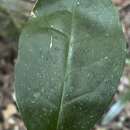mk
имиња во трошки


Die pok-ysterhout (Chionanthus foveolatus) is 'n klein tot groot boom wat aan die kusgebiede en bergwoude voorkom vanaf Kaapstad tot in Mosambiek. Dit kom ook in Limpopo voor. In Engels staan die boom bekend as die pock ironwoord.
Die pok-ysterhout (Chionanthus foveolatus) is 'n klein tot groot boom wat aan die kusgebiede en bergwoude voorkom vanaf Kaapstad tot in Mosambiek. Dit kom ook in Limpopo voor. In Engels staan die boom bekend as die pock ironwoord.
Chionanthus foveolatus, commonly known as the pock ironwood or bastard ironwood, is a medium-sized, evergreen, Afromontane tree that is native to South Africa, Eswatini and Malawi.[1]
Chionanthus foveolatus occurs at medium to high altitudes in habitats ranging from bushy or rocky hillsides and mountainous forests to coastal scrub.
It has scaly grey bark and bears clusters of sweetly scented, cream-white flowers from September to December. It is related to the familiar edible olive, and likewise produces fleshy, ovoid, fruits which become black when ripe. It can be grown easily from seed. It can reach a height of about 10 metres in deep forest though it is usually considerably smaller than this, and it has a spread of about 5 metres. It grows well in full sun or semi-shade.
Chionanthus foveolatus, commonly known as the pock ironwood or bastard ironwood, is a medium-sized, evergreen, Afromontane tree that is native to South Africa, Eswatini and Malawi.
Chionanthus foveolatus occurs at medium to high altitudes in habitats ranging from bushy or rocky hillsides and mountainous forests to coastal scrub.
It has scaly grey bark and bears clusters of sweetly scented, cream-white flowers from September to December. It is related to the familiar edible olive, and likewise produces fleshy, ovoid, fruits which become black when ripe. It can be grown easily from seed. It can reach a height of about 10 metres in deep forest though it is usually considerably smaller than this, and it has a spread of about 5 metres. It grows well in full sun or semi-shade.